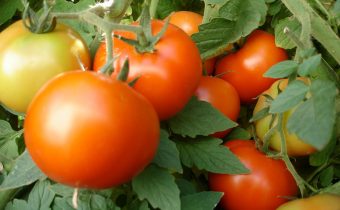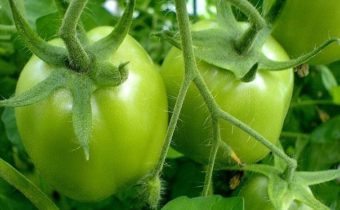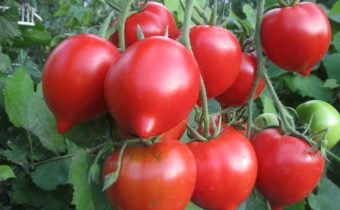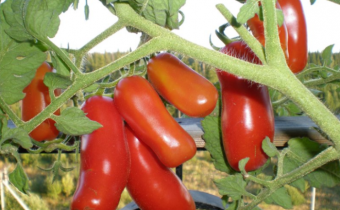Tomato "Zhenya": superearly with impressive yield
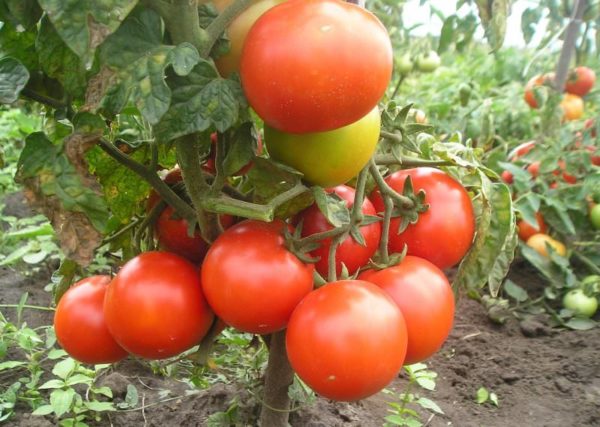
After a long winter with plastic store tomatoes, every gardener can’t wait for his very first, own tomatoes. To get real fragrant tomatoes, you need to have at least a few early tomato bushes in reserve, which will delight at the beginning of summer.
These varieties include the Zhenechka tomato, which, according to the characteristics and description of the variety, belongs to superearly tomatoes, while reviews and photos indicate a very impressive yield for early varieties.
Tomato refers to early varieties with a maturity of 80-85 days after germination. The plant is determinant, undersized. Fruit ripening amicable. Stable yields medium-sized tasty fruits, even with cold snaps. The variety "Genia" is bred for cultivation in central Russia, as well as in the Urals and Siberia.
The main thing about the variety
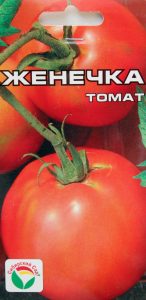 The plant is undersized - 35-45 cm tall, bush of medium branching, compact, moderately broad. Does not require the formation and pruning (removed only the leaves that grow to the first brush).
The plant is undersized - 35-45 cm tall, bush of medium branching, compact, moderately broad. Does not require the formation and pruning (removed only the leaves that grow to the first brush).
Fruits are tied with brushes - up to 4 on the plant. Productivity - up to 3 kg from a bush. The fruits are fairly smooth:
- shape rounded, slightly ribbed;
- weight from 80 to 100g;
- ripe tomato red;
- the pulp is juicy, sweet and sour;
- do not crack;
- The use of tomatoes is universal - for the preparation of salads, various dishes, for preservation.
Pests and diseases
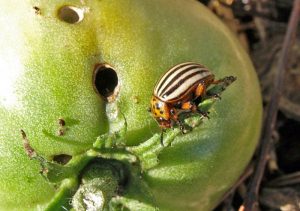 Early tomatoes have a great advantage over other varieties, since their fruiting ends by the time of the onset of August fogs and cold snaps.
Early tomatoes have a great advantage over other varieties, since their fruiting ends by the time of the onset of August fogs and cold snaps.
Since the variety is bred specifically for areas with risky agriculture, it is characterized by resistance to temperature extremes and unpretentiousness.
For prevention, at risk of disease, the plants are treated with phytosporin and copper-containing drugs.
The most dangerous pests of tomatoes are the Colorado beetles, wireworms, crunches (larvae of the May beetle), as well as whiteflies and slugs.
To scare the Colorado potato beetle from planting use birch tar, diluted in a liquid soap. Composition sprayed the soil around the plants.
Colorado beetles are harvested by hand, preventing larvae that can leave the plant without leaves.
See also: Tomatoes series "Gnome" - in the garden and in the plate
If it is fairly easy to detect terrestrial insects, it is only possible to detect a wireworm or crunchy, if the results of its harm are already visible - the plants are oppressed and wither. Undermining the soil near the roots, you can find these yellow worms.
Advantages and disadvantages
The main advantage of the variety "Genia" - its precocity. In most reviews, summer residents also note other positive characteristics:

- unpretentiousness;
- compactness of the bushes, which allows to grow tomatoes, occupying small areas;
- stability;
- high yield for early varieties;
- disease resistance.
Some people consider the sour taste of tomatoes to be a disadvantage, but against the background of early ripening of fruits, it is leveled.
Features agrotehnika
To grow seedlings of tomato "Genia" by mid-May, it is necessary to start preparing seeds for March 10-15.
Sowing and caring for seedlings
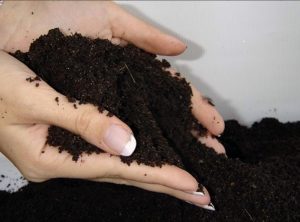 Seeds before sowing are processed:
Seeds before sowing are processed:
- Disinfection in a solution of potassium perfmanganate or phytosporine (exposure time 20 min), followed by washing in water.
- Exposure to a solution of trace elements or stimulants for 6 hours.
Soil for planting seedlings buy ready or make themselves from a mixture of turf decontaminated land, compost, peat, ash. If the soil is not light enough, sand or coconut substrate is added to it.
See also: Diseases of tomatoes in the greenhouse and their treatment
For disinfection of the land it is treated with a weak solution of potassium permanganate or steamed at a high temperature.
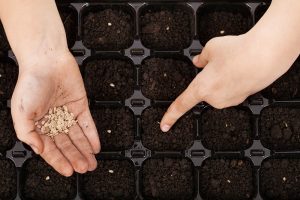 Seeds that have undergone treatment are planted in a container with moistened soil after 2-3 cm. The layer of earth on top of the seeds should be no more than 5-7mm. The container is placed in a plastic bag or covered with a film, creating a greenhouse effect, while it is necessary to leave small holes. There should be drainage holes in the bottom of the container with seedlings.
Seeds that have undergone treatment are planted in a container with moistened soil after 2-3 cm. The layer of earth on top of the seeds should be no more than 5-7mm. The container is placed in a plastic bag or covered with a film, creating a greenhouse effect, while it is necessary to leave small holes. There should be drainage holes in the bottom of the container with seedlings.
Sown seeds contain for several days at a temperature of 24-26 degrees. It is desirable to control the emergence of seedlings. When the first loops appear, the containers are exposed to light. If there are cloudy days, add artificial lighting so that the seedlings are not stretched.
The grown seedlings are watered moderately, only when the soil dries out, they are fed with fertilizers. After the formation of the first true leaves, the plants dive - sit in cups or larger containers. At the same time the distance between the tomatoes is kept 15-20cm.
On the onset of warmer days, seedlings for adaptation are brought to closed verandas or greenhouses.
Planting seedlings in the ground
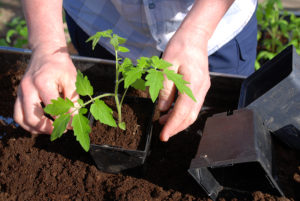 Summer residents wishing to achieve even earlier harvests are preparing tunnel or other temporary shelters for planting tomatoes. They will come in handy at night frosts, since even the most resistant tomatoes do not withstand freezing temperatures.
Summer residents wishing to achieve even earlier harvests are preparing tunnel or other temporary shelters for planting tomatoes. They will come in handy at night frosts, since even the most resistant tomatoes do not withstand freezing temperatures.
By early June, the need for these temporary shelters disappears, and they are removed until next season.
The soil for tomatoes is selected taking into account crop rotation, the best predecessors of tomatoes are beets, peas, cucumbers. After growing on the beds of solanaceous crops, it is desirable to return to them no sooner than three years later.
The wells under the tomatoes mark at a distance in a row after 30-35cm, between rows 60-70cm. They add compost, mineral fertilizers, ash. Before planting the soil is abundantly watered.
Planted plants better in cloudy weather or in the evening. If the weather is hot, the plants cover from the sun so that they do not drop in the first 2-3 days.
Plant care
In the following days after planting, the tomatoes are weeded, watered once a week. After 7-10 days you can spend the first feeding, usually with green fertilizer - diluted with grass extract.
After setting fruits add diluted mineral fertilizers.
See also: Characteristics and description of a hybrid of tomatoes "Evpator F1"
Since the fruit ripens a lot, it is desirable to tie the stems to small supports.It is not necessary to form bushes, however, after the formation of the first brush, the lower yellowed leaves can be cut off.
Dacha farmers remove the first tomatoes of the Zhenechka variety already at the end of June, the variety overtakes the greenhouse tomatoes in ripening terms.
Video: Proper care of tomatoes



 (6 ratings, average: 3,50 from 5)
(6 ratings, average: 3,50 from 5)